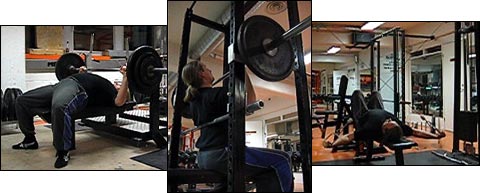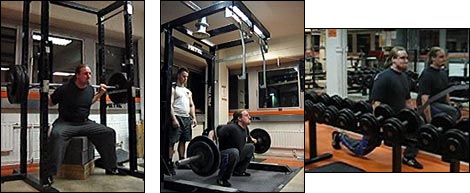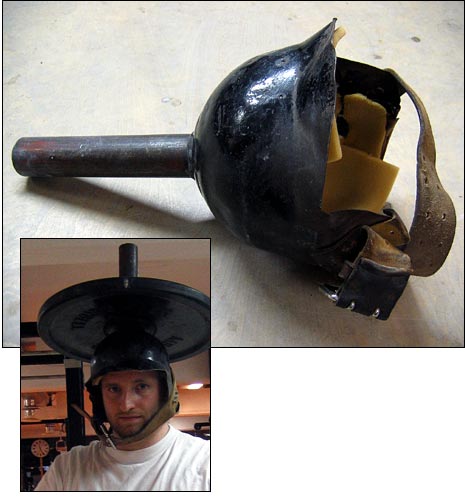2006 archives (page 3)
April 29, 2006
Week 16: Higher ground
Saturday, 22 April 2006: ME Bench
Bench day, back to the widened grip. Based on a radical loss of speed similar to illegal wide benching and some acute shoulder discomfort as the bar drifted towards the throat as I missed the last attempt, I have some reason to suspect that I took my middle fingers for my ring fingers. Can’t really tell from the clip (6.9M). Be that as it may, the only fingers I want on the ring for now is the ring fingers. I sense a faint… association.Followed up with a standard array of accessories. The seated pin presses went well. Not having a board handy, I rigged them up the usual way with a short curl bar as the back rest; only nose-haters do these off an incline bench. Got 3x5 @ 60 kg/133 lbs. Any guesses on what my max will be next ME workout when I will do this one first in the workout for a single? For reference, the best I’ve ever done is 2 @ 70 kg/155 lbs.
worked up to 2 @ 90 kg/199 lbs
0 @ 100 kg/221 lbs
4 supersets:
Seated pin press:
5 @ 50 kg/111 lbs
3x5 @ 60 kg/133 lbs
Chest supported T-bar row: 4x8 @ 55 kg/122 lbs
2 supersets:
Close-grip pulldown: 2x10 @ ??? (forgot to write down)
Cable crossover lying rear delt flye: 2x10 @ 15 kg/33 lbs (per side)
Metal cable preacher curl: 15 @ 3 plates
Sunday, 23 April 2006: ME Squat
I love to squat. After being sidetracked for so long, it feels great to surf on a good gain wave again. If anything, this high box squat session boosted my confidence even more. Got a good shot at 150 kg/332 lbs, alas… As the video (7.3M) will no doubt reveal, the attempts were very uneven; just look at the contrast between the 140 kg/309 lbs that I nearly dumped forward and the subsequent easy 145 kg/320 lbs follow-up. I have since reflected a bit on my form, especially in regard to how I set-up, after having watched the excellent NASA DVD Trouble Shooting Your Own Lifts. I will experiment a bit during DE day and return with my observations in the next weekly installment. The next two ME sessions, I will set a new parallel box PR (shooting for 135-140 kg/298-309 lbs) before annihilating the contemptibly small 120 kg/265 lbs squat record from February. That’s the plan anyway.
Feeling quite beat after the last three high box attempts, I was happy with a sloppy set of Westside cambered bar squats and an even sloppier set of walking dumbell lunges across the gym. I must have taken a somewhat longer stride (go glutes, go!) this time, because I only got 15 steps in as opposed to the usual 16. Trying to look good on camera, eh? Eh? Got a long way to go, Mister. Mango soup anyone? Reverse hypers and out seconds before midnight.
5 @ 50 kg/111 lbs
3 @ 60 kg/133 lbs
3 @ 70 kg/155 lbs
3 @ 80 kg/177 lbs
3 @ 90 kg/199 lbs
3 @ 100 kg/221 lbs (belt on)
2 @ 110 kg/243 lbs PR!
2 @ 120 kg/265 lbs PR!
1 @ 130 kg/287 lbs PR!
1 @ 140 kg/309 lbs PR!
1 @ 145 kg/320 lbs PR!
0 @ 150 kg/332 lbs
Full westside cambered bar squat, close stance: 8 @ 80 kg/177 lbs
Walking dumbell lunge: 15 @ 13.5 kg/30 lbs dumbells
Reverse hyper: worked up to 6 @ 65 kg/144 lbs
Reverse hyper wear and tear
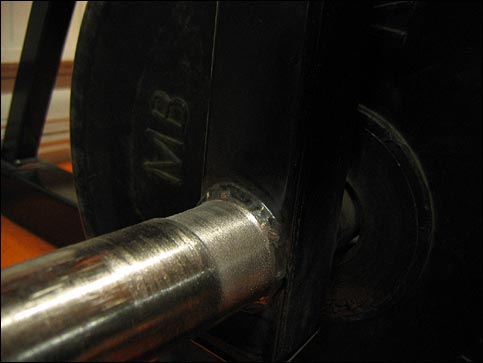
The reverse hyper loading pin showing off some astonishing wear, incidentally of the same width as a 20 kg/44 lbs plate… the dent is most pronounced at the top, with very little on the underside. Pretty much the same thing that happens to joints subjected to years of mechanical stress under maximal loads. This is where you, like me, hope I’m at least half kidding.
May 6, 2006
Week 17: Sore, tired, but somewhat enlightened
Thursday, 27 April 2006: Bench weakpoint day
Nothing like pumping the hell out of thight biceps. I did the standard barbell curls and dumbell benches with bands, even got a nice increase on them, then left the guns alone. Worked light on the accessories; realized that sitting down on the plate raises makes the exercise MUCH harder. Not that I have been swaying around doing them standing, but there’s a world of difference between a little well intended momentum and none at all.
Standing barbell curl: 5,5,5,6 @ 42.5 kg/94 lbs
Dumbell bench:
6,5,6 @ 28.5 kg/63 lbs + light band
5 @ 36 kg/80 lbs
Seated plate raise: 3x10 @ 15 kg/33 lbs
Incline rear delt dumbell raise: 3x12 @ 5 kg/11 lbs
Pressdown in lat pulley: 9 @ 8th
Saturday, 29 April 2006: DE Squat
 This session almost buried me. I had a feeling I was not quite recovered, but only realized how sluggish my legs were when the speed box squat felt like near max work. The idea was to work on unracking the bar cleanly with the legs insted of partially picking the weight off the rack with the back (for reference, see how I set up my squat with NO leg movement whatsoever on the recent high-box video). I don’t think I have a serious problem there, but the NASA video made me aware of this tendency that usually results in the lifter being slightly bent over when the attempt begins. In a meet, this could result in red lights, especially if the knees are not properly straightened. Stubbornly finished the [low]speed work, then did some light pumping accessories. Still, they killed me some more.
This session almost buried me. I had a feeling I was not quite recovered, but only realized how sluggish my legs were when the speed box squat felt like near max work. The idea was to work on unracking the bar cleanly with the legs insted of partially picking the weight off the rack with the back (for reference, see how I set up my squat with NO leg movement whatsoever on the recent high-box video). I don’t think I have a serious problem there, but the NASA video made me aware of this tendency that usually results in the lifter being slightly bent over when the attempt begins. In a meet, this could result in red lights, especially if the knees are not properly straightened. Stubbornly finished the [low]speed work, then did some light pumping accessories. Still, they killed me some more.
Contrary to what one might expect given the aforementioned dire circumstances, this workout expanded my powerlifting mind. A guy, whose path I have never crossed at this very late hour at Metal Gym, was in there working up towards a new PR on the squat. It was his final session after a brutal high-volume squat program done together with one of the gym’s elite squatters and he was looking to smash his 160 kg/354 lbs personal best. Once he was up at 170 kg/376 lbs he asked if I could spot him. Truth be told, I haven’t done a lot of spotting on the squat, but I do know how it is done. He made the lift unassisted and then loaded up for 180 kg/398 lbs. The lift was a bit high, but, save for some help in getting the bar back into the rack, he got it by himself. Next, he dropped the weight back to 160 kg/354 lbs for a double. During the lift I was keeping a close eye on the bar since it is a good indicator of how the lift is going. Some straining, but he got the first rep. On the second rep, the bar rolled down a good bit which in turn pushed him forward into a nosedive. Right then and there, even before my arms left his chest and the bar was back where it started, I realized that I had just seen an aspect of the squat that I had never thought about. And I had seen it from the best perspective possible, merely inches away. Limited as my experience may be, I am now convinced that one of the best ways of observing the mechanics of a squat and what can go wrong is to spot plenty of squats. Breathe up the neck of a squatter if you will. It would be a folly to think that the best gains and insights are made when training in solitude. Think about it, what would you learn more from: a) observing just clips of your own lifts or b) also being part of a lifting collective that includes spotting, observing the lifts of a small horde of lifters every week and casual gym discussions about technique? As much as I enjoy the moonlight sessions together with Måns, I have decided to reschedule at least some of my weekly sessions in the autumn to coincide with the time when the gym is full of life. I will be home with Rufus full-time beginning September 1st; this means Sanna can relieve me after she comes home from work.
I learned two important things today, namely that the education of a powerlifter is a social endevour and that having the bar roll down your back can kill you in a really bad way.
GHR, narrow: 2x15
Standing cable crunch with stability ball: 3x10 @ 8th (40 kg/88 lbs?)
Reverse hyper: 12 @ 40 kg/88 lbs
May 10, 2006
May 15, 2006
The Powerlifting Relative Strength Calculator
It took a few nights of work, but it is time to proudly unveil the Powerlifting Relative Strength Calculator and hope that no major bugs are lurking in the shadows. Here’s where you, dear reader, come in… test it and let me know if it is squirming. In a nutshell, this calculator computes relative strength by all common formulas (Wilks, Reshel, Glossbrenner, NASA, Siff and Schwartz/Malone) for one or more lifters. If this is unfamiliar territory for you, the calculator also comes with a fairly thorough introduction.
May 20, 2006
Siff’s Bodymass Adjustment Formula
Unlike the Powerlifting Relative Strength Calculator, the Siff’s Bodymass Adjustment Formula operates on any combination of squat, bench, deadlift and total results. As usual, this one can also rank up to thirty lifters at a go. If anyone needs more, it can easily be arranged.
Feedback welcome. ![]()
May 23, 2006
Andreas Thorkildsen’s blog is something else
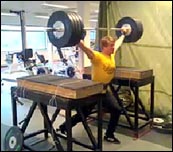 A raw bench press of 180 kg/398 lbs and a near miss at the same weight in the back jerk. If it weren’t for the gymnastics (try the push up to dip combination on for size…), incredible depth jumping, weird specialty exercises and a lot of javelins flowing all over the place, you’d think that would be the work of a decently strong powerlifter. Think again. Thorkildsen is one of the top names in javelin with a personal best of 90.13m and a gold metal from the Olympic Games in Athens 2004. His blog is well worth a read for anyone who is interested in seeing how a top athlete works the weights for sport specificity (the bounce on the bench reminds me of the clip I once linked to, since gone, where shotputter Manuel Martinez bounced 300 kg/663 lbs off pads on his chest). I actually find myself quite interested in the javelin stuff too, perhaps it’s because I’ve entertained thoughts of picking up shotputting for fun to accompany the powerlifting stuff for some time now.
A raw bench press of 180 kg/398 lbs and a near miss at the same weight in the back jerk. If it weren’t for the gymnastics (try the push up to dip combination on for size…), incredible depth jumping, weird specialty exercises and a lot of javelins flowing all over the place, you’d think that would be the work of a decently strong powerlifter. Think again. Thorkildsen is one of the top names in javelin with a personal best of 90.13m and a gold metal from the Olympic Games in Athens 2004. His blog is well worth a read for anyone who is interested in seeing how a top athlete works the weights for sport specificity (the bounce on the bench reminds me of the clip I once linked to, since gone, where shotputter Manuel Martinez bounced 300 kg/663 lbs off pads on his chest). I actually find myself quite interested in the javelin stuff too, perhaps it’s because I’ve entertained thoughts of picking up shotputting for fun to accompany the powerlifting stuff for some time now.
May 26, 2006
Week 18: Mud racing
Thursday, 4 May 2006: ME Bench
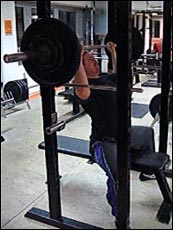 Last week was lethargic, this was a bit worse. It could be the increasingly hectic pace at work as we are nearing the end of the school year or just creeping death (also known as overtraining), but the fact remains… I thought I was capable of a bit more, but bumped up my PR on the seated pin press to 75 kg/166 lbs (VIDEO, 618K) and then went bodybuilding for a good pump.
Last week was lethargic, this was a bit worse. It could be the increasingly hectic pace at work as we are nearing the end of the school year or just creeping death (also known as overtraining), but the fact remains… I thought I was capable of a bit more, but bumped up my PR on the seated pin press to 75 kg/166 lbs (VIDEO, 618K) and then went bodybuilding for a good pump.
10 @ 30 kg/66 lbs
5 @ 40 kg/88 lbs
5 @ 50 kg/111 lbs
1 @ 60 kg/133 lbs
1 @ 70 kg/155 lbs
1 @ 75 kg/166 lbs (PR)
Metal iso-lateral shoulder press: 2x15 @ 20 kg/44 lbs per side
Parallel grip pulldown: 2x15 @ 12th (60 kg/133 lbs?)
Lying L-flye: 2x15 @ 5 kg/11 lbs
Standing alternate dumbell curl: 10 @ 16 kg/35 lbs
Saturday, 6 May 2006: ME Squat
Sluggishness aside, I figured I’d improve on my 13″ box squat PR a bit. Didn’t get good drive off the box and paid the price in forward lean. 135 kg/298 lbs went straight into the pins. That’s it, deload week next.
5 @ 40 kg/88 lbs
3 @ 50 kg/111 lbs
3 @ 60 kg/133 lbs
2 @ 70 kg/155 lbs
2 @ 80 kg/177 lbs
1 @ 90 kg/199 lbs
1 @ 100 kg/221 lbs (belt on)
1 @ 115 kg/254 lbs
1 @ 125 kg/276 lbs
0 @ 135 kg/298 lbs
0 @ 132.5 kg/293 lbs
Standing cable crunch with stability ball: 8 @ 9th (45 kg/99 lbs?)
May 27, 2006
Week 19: Deload fun with max reps
Wednesday, 10 May 2006 (?): Bench deload
Set out to shatter the stability ball dumbell bench rep max I set during the previous deload. Got 29 reps with the 23.5 kg/52 lbs then, now raised the bar for the next deload with 22 reps with the 26 kg/57 lbs bells. We are pleased.
Dumbell flye on stability ball: 2x15 @ 11 kg/24 lbs
Metal iso-lateral seated row: 2x15 @ 25 kg/55 lbs per side
Cable crossover lying rear delt flye: 12 @ 15 kg/33 lbs (per side)
Lying cable curl:
8 @ 55 kg/122 lbs
12 @ 45 kg/99 lbs
Pressdown in lat pulley: 20 @ 5th (25 kg/55 lbs?)
Friday, 12 May 2006: Squat deload
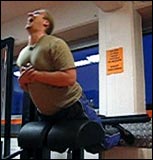 Up and down, up and down, up and down… before I knew it, I had pumped out 31 reps on the GHR. That’s a four rep gain over the previous rep max. Caught it on video (3.5M) this time, critique welcome as usual. Wrapped up with a few light sets of reverse hypers, then off into a looooong shower.
Up and down, up and down, up and down… before I knew it, I had pumped out 31 reps on the GHR. That’s a four rep gain over the previous rep max. Caught it on video (3.5M) this time, critique welcome as usual. Wrapped up with a few light sets of reverse hypers, then off into a looooong shower.
Reverse hyper:
15 @ 20 kg/44 lbs
2x15 @ 30 kg/66 lbs
June 4, 2006
Horse liniment
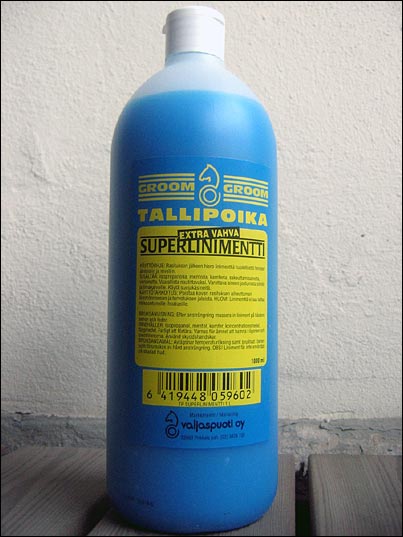
It all began when I found a thread over at Westsidebar discussing this very topic. The general party line was that normal cold liniments do not penetrate much deeper than the skin, but opinions diverged on whether the equestrian variety went much deeper to be effective. Apparently, some physical therapists recommend horse liniments precisely for this reasons, while others feel only ice delivers. Sanna also recalled that she had heard about the use of horse liniments during her massage therapy studies. Comparing the horse liniment with Ice Power and Cool Power (both common cold liniments sold here in Finland), it would appear that the active ingredients in cold liniments are some form of alcohol (isopropanol, ethanol or denatured alcohol), menthol, and possibly camphor (the horse liniment) or eucalyptus oil (Ice Power). The rest are standard cosmetic ingredients that gives the liniment its ice blue color or gel-like consistency. The horse liniment is much more runny than Ice Power, probably because it is easier to smear quickly over a large horse that way, and lacks glycerin or its equivalents.
Let me put it this way: the ingredient list (isopropanol, menthol, camphor, thickening agent and food colors) of the horse liniment I bought reveals no super potent ingredient not found in the standard cold liniments sold in pharmacies and sports departments, unless that would be camphor… If the horse liniment is more effective it is because it has higher concentrations of active ingredients than the human intended brands. The major reason, besides the possibility that it is indeed a tad more potent, to mess around with horse liniments would appear to be price. I paid 9 euros for a liter of horse liniment from the equestrian section of a local supermarket whereas the liter price of Ice Power is 50 euros if bought in the biggest container. Think about that for a second. Thomas Deebel pretty much summed it up when he was asked why EliteFTS only sell veterinary liniments:
The vet products are actually cheaper for you to purchase. The liniments I have to sell in my office are actually about the same, but cost 4X as much money.
There you have it. Sorry for dissolving the mystique surrounding the powerlifter as a mighty horse.
